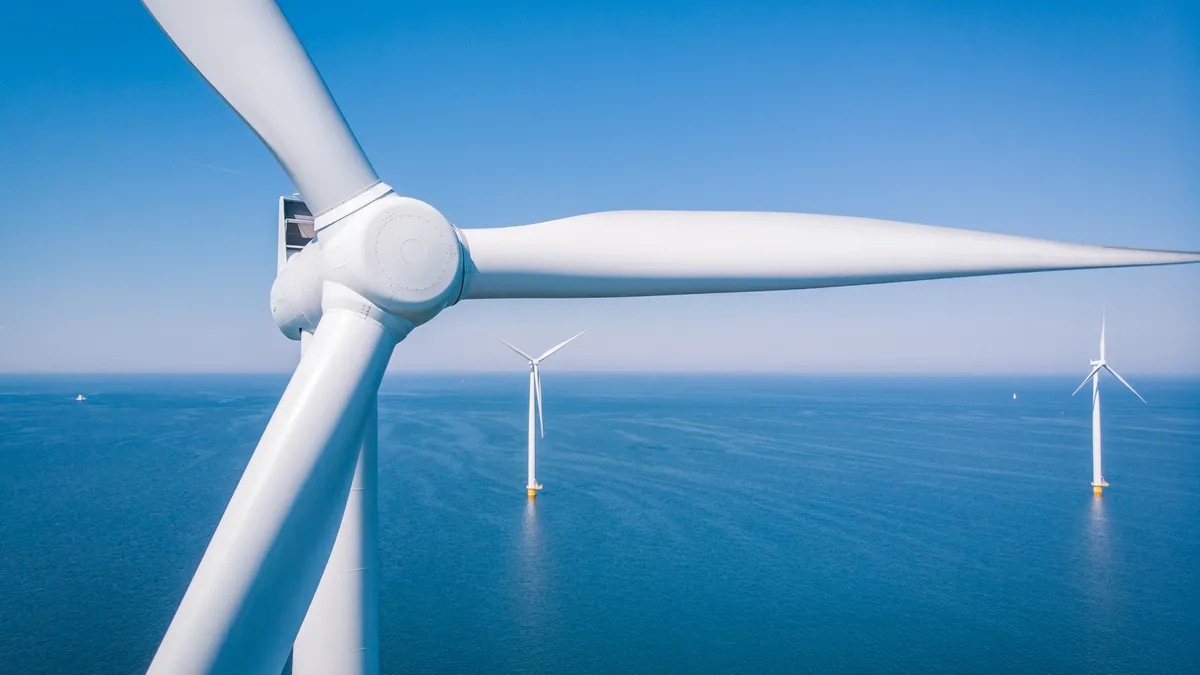Dive Brief:
- Five companies are the provisional winners of the offshore wind leases available for up to 4.6 GW from floating turbines off of California’s central and northern coasts, the Bureau of Ocean Energy Management, or BOEM, announced Dec. 7.
- While the auction is a significant first step, many more are needed to bring California’s floating wind turbine industry to fruition, including a U.S.-based supply chain, new transmission and offtake agreements.
- The leaseholders are required to fund workforce training or support the development of a domestic supply chain for the floating wind energy industry, or do both, which will give them a 20% bidding credit. There is also a 5% bidding credit for signing agreements that benefit the communities impacted by the lease developments, which along with lease provisions, show “ BOEM’s commitment to responsibly grow the offshore wind industry to achieve our offshore wind goals,” said BOEM Director Amanda Lefton.
Dive Insight:
The results of BOEM’s lease sale this week for emerging floating wind turbines have generated much excitement among wind advocates although the bids were about one-fourth of revenue, on a per megawatt basis, produced by the New York and New Jersey auction in February for up to 7 GW of offshore wind. And big hurdles lie ahead.
The just completed “lease sales mark an important moment for floating offshore wind in U.S. waters,” Liz Burdock, executive director of Business Network for Offshore Wind, said in a Dec. 7 statement.
“We are going to pop some champagne bottle corks tonight,” Matthew Marshall, executive director of the Humboldt-based Redwood Coast Energy Authority, or RCEA, said during a Wednesday phone call.
RWE Offshore Wind Holdings and Copenhagen Infrastructure Partners’ California North Floating successfully bid a total of $331.5 million for two BOEM leases covering more than 132,370 acres off the north coast. Marshall believed the bids would be lower than they were because of the transmission constraints in the Humboldt region.
Another surprise was that the per acre bids in the north coast were higher than those of the three successful ones in the deep Continental Shelf off the coast of Morro Bay given the latter’s transmission infrastructure.
The winning central coast bids totaled $425.6 million for 240,900 acres in the water of the Continental Shelf. The successful bidders were Equinor, Invenergy California Offshore and Central California Offshore.
Morro Bay, unlike Humboldt, has well-developed transmission that sends power from the 2.2 GW Diablo Canyon Nuclear Power Plant to the grid, and which could also carry floating wind turbine energy. Diablo’s life, however, may be extended to 2030, five years past the date its current federal operating license expires. Marshall and others see this as a possible impediment to a central coast offshore wind industry.
To help clear the way for a robust offshore wind industry in Humboldt, RCEA hopes to work with RWE and California North Floating on developing 150 MW of offshore wind energy. Developing 10 turbines will “get steel in the water,” while needed new transmission, expected to take a decade, gets built, Marshall said.
There are other key impediments to reaching both California’s goal of up to 5 GW of floating offshore wind energy by 2030, and the Biden Administration's target of 30 GW of offshore wind in the U.S. the same year.
Nancy Rader, CalWEA executive director, said during a Dec. 7 phone call that the winning BOEM bids were well below those of the East Coast in February partly because of a lack of power purchase agreements for the expected offshore wind power. The good news, she added, is that the costs of the offtake agreements “will be low.”
Marshall agreed, saying that the New York and New Jersey lease sales generated an impressive $4.4 billion for up to 7 GW because they came with state commitments to buy the installed wind power.
The Business Network’s Burdock said industry, government and others must quickly begin building “a strong domestic supply chain to support the new industry and advance the port and transmission infrastructure necessary to ensure market readiness.”
The California Energy Commission in March approved a $10.5 million grant for upgrades at the port of Humboldt to support an offshore wind industry.
BOEM Director Lefton highlighted Dec. 7 that the California auction commits $117 million “to support economic growth from floating offshore wind energy development – including the jobs that come with it.” Workforce and supply chain advancement and community benefits are required as part of the lease agreements, according to Marshall.
|
Provisional Winner |
Lease Area |
Acres |
High Bid |
|
RWE Offshore Wind Holdings |
OCS-P 0561 |
63,338 |
$157.7 million |
|
California North Floating |
OCS-P 0562 |
69,031 |
$173.8 million |
|
Equinor Wind US |
OCS-P 0563 |
80,062 |
$130 million |
|
Central California Offshore Wind |
OCS-P 0564 |
80,418 |
$150.3 million |
|
Invenergy California Offshore |
OCS-P 0565 |
80,418 |
$145.3 million |
Source: BOEM
Correction: A previous version of this story misidentified a winner of this week's auction. It is Equinor Wind US. Also, we have updated this story to clarify statements from Nancy Rader on why the winning bids were below those on the East Coast.














